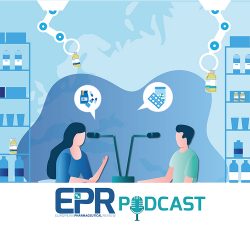
European Pharmaceutical Review podcast
EPR Podcast Episode 12 – Digital twins in R&D – Loredana Vagaggini, GSK

As the industry works to establish interconnectivity leveraging automation, machine learning and real-time data in the transition to Pharma 4.0, digital twins have emerged as a solution to increase productivity and efficiency in drug development and manufacturing, while also enhancing quality. In our latest episode, Loredana Vagaggini, Senior Manager Principal Product Owner, Vx Tech R&D at GSK discusses the use of digital twins in pharmaceutical development and manufacturing.
What are digital twins and why are they being used by the pharma industry?
Loredana explains how, though there are different types of implementation, all involve the creation of a digital virtual equivalent of a real-life process, product or service. “What varies among the different implementations is the extent to which you build automated connections between the two worlds,” discussing the three stages of automation and thus twins:
- Level one – Digital Model – a virtual copy of something physical
- Level two – Digital Shadow – implementing a data flow to connect the physical world and digital model
- Level three – Full Digital Twin – implementing a flow of data from the physical world to the digital copy and a flow from the digital copy back to the physical.
The major benefits, particularly in the vaccines space, is that digital twins help develop and manufacture products quickly. This, says Loredana, is critical following COVID-19 and something which traditional R&D methods cannot necessarily provide for.
What projects have GSK undertaken with digital twins and how are they used in vaccine technical research and development (TRD)?
“Digital twins are actively being implemented in R&D and manufacturing,” with a range of applications from process development (where Loredana works) to predictive maintenance in manufacturing processes.
“The digital twins [my team] are building are for process development in vaccine TRD. We are working at building a library of twins supporting the different steps of the process,” she explains. They develop mechanistic models based on scientific knowledge to allow them to implement them early in the process, where historical data is minimal. “So we have these mechanistic models and we use them to produce simulated data.. with which we train machine learning models so we can have faster calculations.” She notes that this conversion is necessary, as where mechanistic models may take days to run machine learning models take seconds, and this faster processing time allows them to control the process with the model – creating a Full Digital Twin.
Taking the example of a bioreactor, with real time data input from sensors, Loredana explains how the machine learning models take the input from the real system, estimate the end quality of the batch and, where necessary, identify actions that are fed back to the physical system.
The same models can also be used in an off-line fashion to simulate experiments, allowing development
How could digital twins develop over the next decade?
“Digital twins are still an emerging technology, and their widespread adoption is expected in the next one to three years,” says Loredana, explaining how companies who have been developing them to date are now looking at opportunities to standardise and industrialise their work. “We can expect digital twins to become an integral component of the process development… and to be a part of the transfer to manufacturing. The other thing we can anticipate is having process digital twins connected to supply chain digital twins,” she explains.
Digital twins are pure innovation. They connect and bring together all sorts of business knowledge and technical capabilities and because of that they have the potential to bring an immense value to the patient and make a difference in allowing faster and better [product] delivery” – Loredana Vagaggini, Vx Tech R&D, GSK
To find out more about the benefits realised through digital twins, the technologies required to establish them, as well as what makes them exciting to Loredana, tune into the episode.
Please join the conversation and leave your thoughts in the comments – we love hearing your feedback – and look out for our next episode coming soon!
The post <em>EPR</em> Podcast Episode 12 – Digital twins in R&D – Loredana Vagaggini, GSK appeared first on European Pharmaceutical Review.